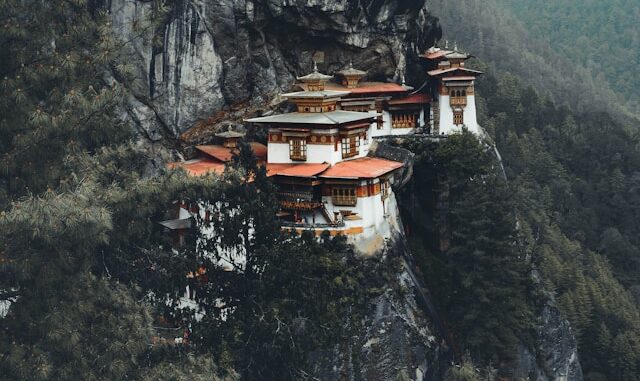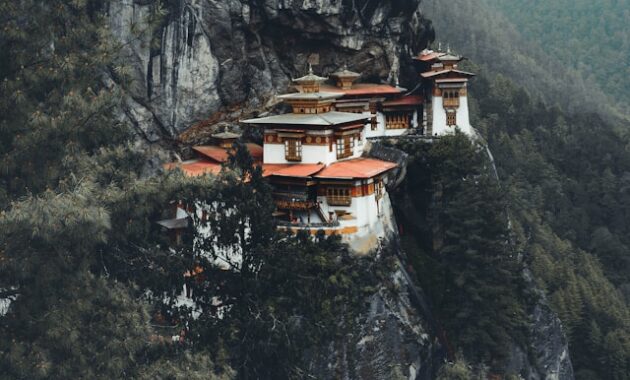
Bhutan, the mystical Himalayan kingdom nestled between China and India, is home to some of the most captivating natural wonders on Earth. Revered for its unspoiled landscapes, rich biodiversity, and commitment to environmental preservation, Bhutan offers travelers a chance to reconnect with nature in its purest form. Here, we present 10 breathtaking natural wonders in Bhutan that should top any adventurer’s travel list.
1. Tiger’s Nest Monastery (Paro Taktsang)

Perched dramatically on a cliffside 3,000 feet above the Paro Valley, the iconic Tiger’s Nest Monastery is not only a spiritual pilgrimage site but also a marvel of nature and architecture combined. The trail to the monastery winds through lush pine forests, prayer-flag-draped paths, and breathtaking views of the surrounding valley, rewarding visitors with a panoramic spectacle unlike any other.
2. Phobjikha Valley – The Glacial Paradise
Phobjikha Valley, located in central Bhutan, is a glacial valley that unfolds like a serene bowl of emerald grasslands surrounded by the Black Mountains. It is also the winter home of the endangered black-necked cranes, which migrate from Tibet. Visitors can hike the Gangtey Nature Trail, which offers unparalleled views and opportunities to witness these majestic birds in their natural habitat.
3. Mount Jomolhari – The Bride of Kangchenjunga
Standing tall at 7,314 meters, Mount Jomolhari dominates the Bhutanese skyline along the northwestern border. Known as the “Bride of Kangchenjunga,” it is sacred to both Buddhists and local communities. The Jomolhari Trekis a thrilling adventure that takes trekkers through alpine meadows, rhododendron forests, and across high mountain passes, offering unmatched views of the snow-capped peaks.
4. Mo Chhu and Pho Chhu Rivers Confluence
In the stunning Punakha Valley, the Mo Chhu (Mother River) and Pho Chhu (Father River) converge just below the majestic Punakha Dzong, creating a striking natural and architectural panorama. The rivers are not only vital lifelines for agriculture but also perfect for white-water rafting, bird-watching, and peaceful walks along the riverbanks surrounded by flowering jacarandas.
5. Haa Valley – Bhutan’s Hidden Gem
Tucked away in western Bhutan, the Haa Valley remains one of the least explored regions, making it a perfect sanctuary for those seeking tranquility and untouched nature. Surrounded by pristine forests, alpine meadows, and snow-dusted peaks, Haa is ideal for trekking, camping, and cultural immersion. The Chelela Pass, en route to Haa, offers panoramic views of the Himalayas and is one of Bhutan’s highest motorable points.
6. Bumdeling Wildlife Sanctuary
Located in the northeastern corner of Bhutan, Bumdeling Wildlife Sanctuary spans over 1,500 square kilometers and is a hotspot for biodiversity. It is home to over 300 bird species, including the black-necked crane, and rare mammals such as the red panda and snow leopard. The sanctuary’s diverse topography—from subtropical forests to alpine pastures—makes it a paradise for nature lovers and eco-tourists.
7. Lhuentse’s Rugged Cliffs and Waterfalls
The remote Lhuentse district, nestled in eastern Bhutan, is renowned for its rugged terrain, deep gorges, and cascading waterfalls. Its mystical ambiance is enhanced by ancient monasteries perched on cliff sides, including the majestic Lhuentse Dzong. The dense forests and roaring rivers here are ideal for off-the-beaten-path exploration, photography, and spiritual retreats.
8. Dochula Pass – 108 Stupas and Himalayan Vistas
Rising at an altitude of 3,100 meters, Dochula Pass is one of Bhutan’s most scenic mountain passes. Adorned with 108 memorial stupas, the pass offers sweeping views of the eastern Himalayas, especially on a clear winter morning. The lush forested hillsides transition into snowy vistas, making it a picture-perfect destination and a photographer’s haven.
9. Merak and Sakteng – Land of the Brokpa Nomads
Nestled in the far eastern region of Bhutan, Merak and Sakteng are high-altitude settlements inhabited by the unique Brokpa community, nomadic herders known for their distinct culture and dress. The surrounding landscape is a blend of untamed wilderness, blooming meadows, and snow-covered ridges, accessible via the Merak-Sakteng Trek, one of Bhutan’s most enchanting and culturally immersive trails.
10. Lake Tshophu – Jewel of the Himalayas
Tucked away in the high altitudes of the Laya-Gasa region, Tshophu Lake is a shimmering glacial lake set against the backdrop of snow-draped peaks and rolling grasslands. Accessible via the Druk Path Trek or the Snowman Trek, this ethereal lake is surrounded by myths and legends and reflects the surreal silence of the high Himalayas. It is a sacred site revered by locals and a soul-soothing destination for trekkers.
Why Bhutan’s Natural Wonders Deserve Global Attention
Bhutan’s remarkable natural beauty stems from its strict environmental conservation policies, including the constitutional mandate to maintain at least 60% forest cover and being the world’s only carbon-negative country. This commitment has preserved Bhutan’s landscapes in a state of pristine magnificence, making it a must-visit for travelers seeking nature, spirituality, and serenity.
The country’s national parks and wildlife sanctuaries cover more than 50% of its territory, creating continuous green corridors that support the survival of some of the rarest species on the planet. Whether you are chasing high-altitude lakes, hidden valleys, or majestic mountains, Bhutan offers a rare blend of natural splendor and cultural authenticity.